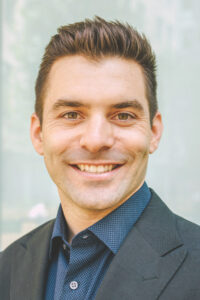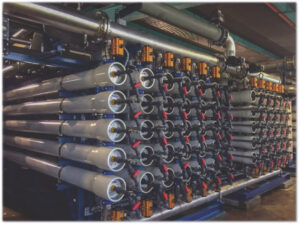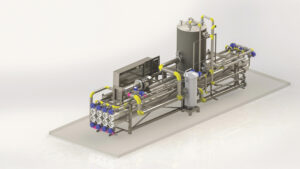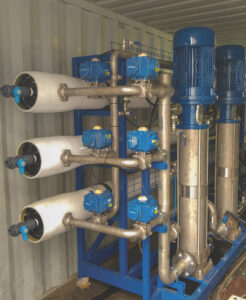How ROTEC Is Improving Desalination Technology Around the World - Municipal Water Leader
Published on by Water Network Research, Official research team of The Water Network in Business

How ROTEC Is Improving Desalination Technology Around the World
February 24, 2019
H igh-recovery reverse osmosis (RO) is becoming a vital solution for both municipal and industrial water portfolios around the world. It is a reliable, drought-resilient water source that in many cases can be more affordable than importing new surface water. RO is also a critical component in the advanced treatment and reuse of municipal wastewater and the mitigation of seawater intrusion into groundwater aquifers.
Historically, RO has been limited in application because of its low recovery rate—the ratio of treated water to feed water in the desalination process. In a system with a 75 percent recovery rate, for every 100 gallons of feed water that enter the system, 75 gallons of permeate are produced while the remaining 25 gallons are discharged as concentrated brine. For most inland RO operators, brine is complicated and costly to manage because of environmental restrictions and limited disposal options.
That’s where ROTEC comes in. The Israeli company has developed a simple but highly effective Flow Reversal method, designed to significantly boost RO recovery while reducing cleaning frequency, chemical consumption, and overall system maintenance.
In this interview, Ben Perlman, president of Smart Water Group, ROTEC’s strategic partner in the United States, speaks with Municipal Water Leader Managing Editor Joshua Dill about how ROTEC’s technology works and how it can help municipal and industrial clients face the water challenges of the future.
 Joshua Dill: Please tell us about your background and how you came to be in your current position.
Joshua Dill: Please tell us about your background and how you came to be in your current position.
Ben Perlman: It was not an obvious path. I graduated from the Wharton School of Business in 2006 with a fantastic degree but without a clear professional direction. So I did what many smart but directionally challenged young professionals do: I joined a local consulting firm. Consulting, as it turns out, is a business with huge highs and very low lows, and I didn’t enjoy the variability of the job. So after 3½ years in Philadelphia, I was yearning for something that would pique my intellectual curiosity and spark my entrepreneurial passion.
In 2010, I moved to Israel and joined up with a group of water entrepreneurs working on some innovative approaches to wastewater treatment. Together, we started building a company called Water Fund Investment Group (WFI Group), which invested in and managed some the brightest water startups in Israel. Today, we represent four of the leading water technology companies in Israel, specializing in a broad spectrum of water treatment methods, from high-recovery RO to decentralized wastewater reuse, selective filtration, and brineless nitrate reduction from groundwater. We have over 50 employees, three engineering offices, two manufacturing hubs, and a full-service research and development laboratory in Israel. It’s quite an operation!
In addition to serving on the board of WFI Group, I’m the president of Smart Water Group, WFI’s commercial arm in the United States. My day-to-day work focuses on strategy and business development. We’re building relationships with consulting and engineering firms that are looking for innovative technologies to give them an edge over the competition. ROTEC is the newest member of our group, and we’re thrilled to be working together.
Joshua Dill: Please tell us about ROTEC and what makes its technology so innovative.
Ben Perlman: ROTEC’s innovation is based on a principle called Flow Reversal, which is designed to inhibit mineral scaling, the limiting factor in high-recovery operations. If you picture a normal RO pressure vessel with a number of membranes operating in a series, the final membrane will always receive the highest concentration of salt during the treatment process. Over time, mineral scaling will begin to precipitate on the final membrane, reducing flux and eventually requiring maintenance, chemical cleaning, and downtime. ROTEC overcomes this challenge by reversing the direction of the flow through the pressure vessel before the mineral scale begins to form, boosting flux and resolubilizing the salt in the process.
By periodically reversing the flow, we reduce scaling and increase output, allowing ROTEC to operate at much higher recovery rates than conventional systems. If a standard two-stage RO system operates at 75–80 percent recovery, ROTEC can deliver 90–95 percent recovery in the same footprint, with the same specific energy requirements. Not only does this translate to a 20 percent increase in permeate production, it also equates to a 60 percent reduction in brine volume, a major cost driver for inland treatment operations. More importantly, reduced brine volume opens up the door to new zero-liquid-discharge applications like thermal evaporation, which simply don’t pencil out in conventional treatment.
ROTEC’s innovation is essentially a self-cleaning mechanism, enabling the system to operate at recovery levels well beyond normal parameters. It is a game changer for the industry.

Image by ROTEC
Joshua Dill: Does your technology also lengthen the lifespan of the membranes themselves?
Ben Perlman: Yes. Flow Reversal not only increases recovery, it decreases the frequency of clean in place (CIP), the method used to clean the interior of the membranes with chemicals. This makes sense, because the Flow Reversal process works as a self-cleaning mechanism, balancing the salt load across each pressure vessel.
Flow Reversal is enabled by a series of smart controllers and automated valves, allowing any element of the system to undergo CIP while the rest of the system is operating at full capacity. Further, all of our systems have the ability to revert back to conventional operation without Flow Reversal, providing our customers with the peace of mind of knowing they have 100 percent fallback redundancy.
It’s important to note that 99 percent of the time, our systems are operating just like conventional RO systems. Our process isn’t a major deviation from what our customers know today. This makes Flow Reversal easier for our customers to conceptualize and adopt.
Joshua Dill: So does your technology involve hardware that can be installed into existing systems?
Ben Perlman: Flow Reversal is a brilliant process, but none of the hardware enabling this process is proprietary. This means that ROTEC can take a conventional RO system operating at 75 percent recovery and, with minimal capital investment, enhance it to industry-leading levels of 90 percent or more.
The cost of performing a Flow Reversal retrofit is significantly lower than the cost of replacing the existing system, but the benefits are the same. For customers who have depreciated their existing assets but are looking to get more out of the infrastructure, this is a very attractive proposition. Between additional water production and brine volume reduction, the savings on a large system could be worth millions of dollars a year.
Joshua Dill: Would you tell us about your experience finding clients in Israel and in the United States?
Ben Perlman: The company was founded in Israel, so we have a good installment base in the surrounding region. We have done a wide variety of treatment applications with Flow Reversal technology, ranging from industrial reuse to ingredient water for foods and beverages to groundwater desalination projects in southern Israel, where the total dissolved solids measure can be as high as 8,000 parts per million.
We have a great relationship with Suez in Spain, focused on industrial treatment in the food and beverage industry. We have completed a number of projects with Coca-Cola Worldwide and just completed our first project with Pepsi Group last year. We look forward to growing that account and expanding to other industrial applications like mining, power, and manufacturing.
We are also involved in a number of exciting municipal reuse applications around the world. We have a new wastewater reuse facility coming online this year at the Shafdan wastewater treatment plant in Tel Aviv, the largest and most advanced treatment plant in Israel. A portion of the secondary-treated wastewater will pass through ROTEC’s RO process for higher-quality industrial reuse applications.

Image by ROTEC
We also have a strong presence in Singapore, collaborating with the Public Utility Board (PUB), the country’s water and wastewater utility. Our involvement with PUB began in 2015, when we embarked on an ambitious pilot project at its Kranji facility. Instead of operating a standalone pilot, PUB asked us to retrofit a major component of its existing treatment plant, which was already producing millions of gallons of treated wastewater for drinking purposes. We retrofitted one-ninth of the plant, a 2,000-gallon-per-minute skid operating as a normal two-pass RO system, into a three-stage system incorporating Flow Reversal technology, without increasing the footprint. The retrofit itself took 10 days to complete, with only 4 days of system downtime. Once completed, the pilot ran at steady-state operations for 18 months, achieving an increase in recovery from 75 percent to 90 percent.
As a result of our success in Kranji, we are now collaborating with Jacobs to integrate Flow Reversal into PUB’s TUAS Plant, the largest membrane bioreactor reuse facility in the world. PUB’s TUAS Plant is designed to recycle wastewater at myriad qualities, the highest of which is achieved through an advanced treatment process incorporating Flow Reversal, engineered for high-purity industrial reuse. ROTEC’s system at TUAS is designed for 30 million gallons a day and is capable of running at a recovery rate of up to 93 percent, among the highest in the world.
These large-scale reuse projects have tremendous potential for the United States. Today, progressive states like California are already embracing municipal reuse, a cost-effective solution for alternative water supply. These solutions are going to become more pervasive around the world. Climate change, urbanization, population growth, and a rising standard of living are all putting pressure on water, the world’s most valuable nature resource. We all need to think smarter about water. ROTEC is one of many companies proactively addressing these issues, and we’re happy to do our part.

Image by ROTEC
Joshua Dill: Do you need to take variations in water chemistry or geology into account when you are installing your technology in different areas of the world?
Ben Perlman: Absolutely. It changes on a case-by-case basis, and for us, everything starts with high-quality data. Our group has been in the business for over a decade now and has run dozens of pilots, so it understands how variations in water chemistry, like iron and silica, affect the RO process. Over the years we have put our technology through the wringer, from super-saline groundwater treatment to complex industrial reuse. Our team is constantly challenging the technology and leveraging operating data to further refine the process. The result is a flexible, robust treatment system, operating at the highest recovery rate in the industry, combined with a process guarantee.
Joshua Dill: Does your process require higher energy use?
Ben Perlman: Surprisingly, no. What we found when we incorporated Flow Reversal into an existing RO system was that the specific energy—the amount of energy consumed as a function of treated water volume—was exactly the same. We aren’t sacrificing energy—or chemicals or maintenance, for that matter—to produce more water.
Joshua Dill: What is your message to our readers?
Ben Perlman: There are a lot of customers out there that can benefit from high-efficiency reuse, and ROTEC plays an important role in this process. Our technology is keeping pace with the changes in expectations faced both by municipal and industrial clients whose communities and shareholders are demanding more innovative and sustainable water solutions. Before the wastewater reaches the RO process, customers are spending significant capital capturing and treating the water to a secondary level. It’s high-value water—so why not strive to recover every drop that’s economically feasible? This is the value that ROTEC is bringing to the industry.
At the end of the day, our customers embrace ROTEC because they understand the importance of long-term water security, quality, and sustainability. The future of water reuse is 100 percent recovery, and ROTEC is a giant step in the right direction.
The interview was originally published by MUNICIPAL WATER LEADER
Media
Taxonomy
- Desalination
- Sea Water Desalinisation
- Sustainable Desalination
- Desalination